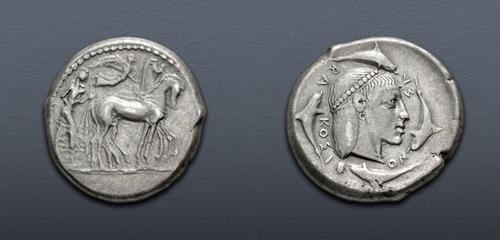|
SICILY, Syracuse. Hieron I. 478-466 BC. AR Tetradrachm (24.5mm, 17.30 g, 4h). ‘Damareteion’ series. Struck circa 470-466 BC. Charioteer, wearing long chiton, holding kentron in right hand, reins in both, driving slow quadriga right; above, Nike, wearing long chiton, flying right, crowning horses with open wreath held in both hands / Head of Arethousa right, wearing pearl tainia, single-pendant earring, and linear necklace; four dolphins and ΣΛ-RΑ-ΚΟΣΙ-ΟΝ around. Boehringer Series XIIe, 387 var. (V–/R275 [unlisted obv. die]); HGC 2, 1308 corr. (Boehringer 387, 388, and 391E of standard style); Du Chastel 64 (same rev. die); Gulbenkian 256 = Jameson 755 (same rev. die); Rizzo pl. XXXV, 9 (same rev. die); Auctiones AG 24, lot 76 (same dies); NAC 126, lot 38 (same rev. die [hammer CHF 85,000]) = Gemini VII, lot 157 (same rev. die [hammer $60,000]). Toned, a few light marks, minor doubling on obverse. VF. An important issue in the evolution of Syracuse tetradrachms. Extremely rare, one of only seven coins known from this reverse die, four of which are in public collections.
From the Jonathan K. Kern Collection, with proceeds being donated to charity.
This fascinating issue represents a landmark in the series of Syracuse tetradrachms. With the advent of the Damaretion coinage, the master engraver introduced a new style that progressed the art of the coins forward, from the static archaized style that had dominated the coinage into a more realistic classical form that was beginning to appear in coinage throughout Sicily and beyond. Although the present issue lacks the salient features of the core Damaretion coinage, the lion in the exergue on the obverse and a laureate head of Arethousa enclosed in a linear circle on the reverse, the die links that Boehringer identified in his corpus clearly links it to the end of the famed series. The obverse and reverse here reflect a return to the standard types that had been used since the early 5th century, but the style is clearly that which had been introduced by the Damaretion master, which is most notable in the presentation of Arethousa. Her static features have been replaced with a serene countenance, with a profile eye prominently displaying her pupil, and her hair flows in a natural, fluid form. This new presentation of Arethousa persisted in the coinage beyond the Damaretion series, and soon other engravers began to experiment with their own interpretations of her form, culminating in the famed period of the "signing artists," whose work exemplified the pinnacle of classical art. In sum, this issue is the first presentation of the standard Syracuse tetradrachm type in classical style.
The final winners of all Triton XXVIII lots will be determined at the live public sale that will be held on 14-15 January 2025.
Triton XXVIII – Session One – Lot 1–287 will be held Tuesday morning, 14 January 2025 beginning at 9:00 AM ET.
Winning bids are subject to a 22.5% buyer's fee for bids placed on this website and 25% for all others.
We recognize that our users may have various Internet Browsers and Operating Systems. We like our visitors to have the best possible experience when using our bidding platform. However, we do recognize that it is impossible to develop applications that work identically, efficiently and effectively on all web browsers. The CNG bidding platform supports the latest stable major version and stable previous version of Chrome and Firefox.
|
